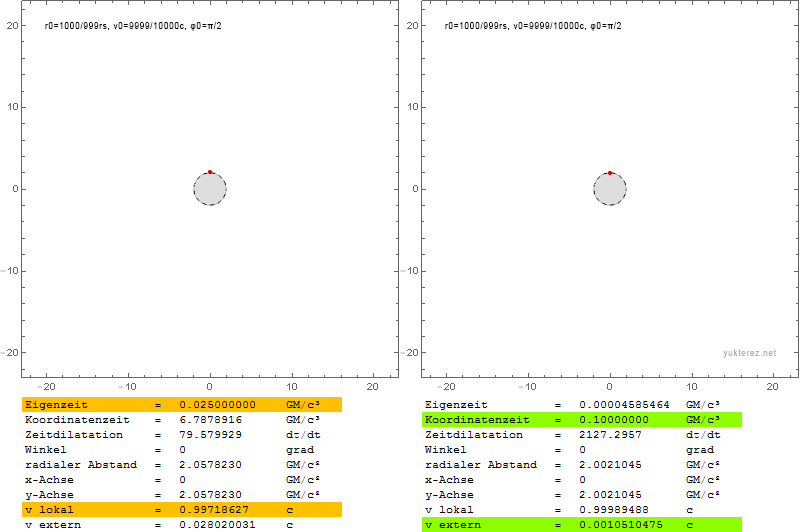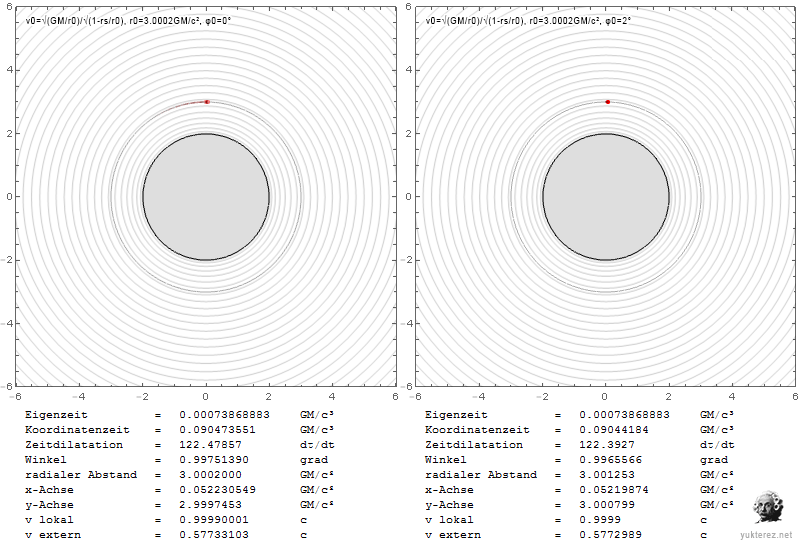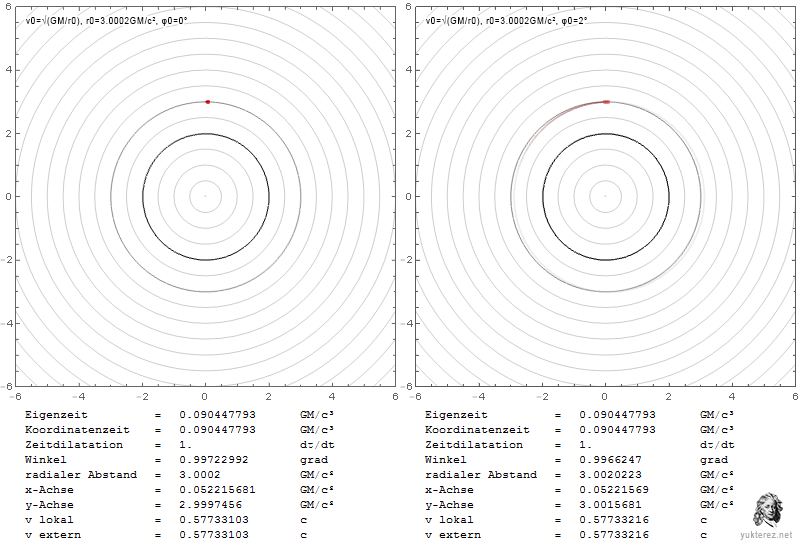I'm guessing your questions all amount to whether general relativistic effects become important at the surface of a neutron star. To answer this we can compare the flat space metric (in polar coordinates):
$$ ds^2 = -c^2dt^2 + dr^2 + r^2 d\Omega^2 \tag{1} $$
with the Schwarzschild metric that describes the geometry outside a spherically symmetric mass:
$$ ds^2 = -\left(1-\frac{2GM}{c^2r}\right)c^2dt^2 + \frac{dr^2}{\left(1-\frac{2GM}{c^2r}\right)} + r^2 d\Omega^2 \tag{2} $$
The difference is that factor of $1-2GM/c^2r$, which we can also write as $1-r_s/r$ where $r_s$ is the Schwarzschild radius - $r_s = 2GM/c^2$. Feeding in the mass and radius of the neutron star we find this factor is about $0.72$, so general relativistic effects are indeed important.
Your question (1) is answered in What is the weight equation through general relativity?. The coordinate acceleration measured by an observer at the surface is:
$$ a = \frac{GM}{r^2}\frac{1}{\sqrt{1-\frac{2GM}{c^2r}}} \tag{3} $$
so it differs from the Newtonian prediction by (in this case) a factor of about $\sqrt{0.72}$.
Re your questions (2) and (3), offhand I don't know the expression for the coordinate acceleration measured far from the star, but it will not be the same as equation (3). A distant observer sees falling objects slow as they approach the event horizon and asymptotically approach zero speed at the horizon. So the coordinate acceleration is obviously different from the coordinate acceleration measured near the horizon.
The local escape velocity is
$$v_{esc} = \sqrt{\text{2 G M}/\text{r}}$$
At infinty you observe that velocity slower by a factor of
$$1-\text{r}_s/\text{r}$$
so at infinity you observe
$$\text{v}_{esc} = \sqrt{\text{2 G M}/\text{r}} \cdot (1-\text{r}_s/\text{r})$$
because of gravitational length contraction radial to the mass and gravitational time dilation in all directions.
The local orbital velocity is
$$v_{orb} = \sqrt{\text{G M}/\text{r}}/\sqrt{1-\text{r}_s/\text{r}}$$
which is at infinity observed to be slower by a factor of
$$\sqrt{1-\text{r}_s/\text{r}}$$
At infinity you observe simply
$$\text{v}_{orb} = \sqrt{\text{G M}/\text{r}}$$
So the observer at infity should observe an orbiting particle orbit with it's newtonian velocity, while locally this velocity is higher.

The Plots show the velocities in terms of v/c and the Schwarzschild r coordinate in units of GM/c². Left is the system of a local observer, and right like an observer at infinity would see the Shapiro-delayed velocities.
Locally the escape velocity equals the orbital velocity at r=4GM/c², while at infinity their equality is observed at r=2·(2+√2)=6.8284GM/c².
At the photon sphere a local observer would observe the orbiting particle with c, while an observer at infinity would measure it slower by a factor of √(1-2/3), so with 0.577c.
An escaping particle near the event horizon would need a local radial velocity of c, and seem to have zero velocity for the observer at infinity.
The different factors for the radial and the transversal components is due the graviational length contraction which is only in radial direction (there is more radius inside the circle than the circumference divided by 2π).
To sum it up:
Locally, the radial escape velocity for Einstein is the same as for Newton. At infinity it is observed slower than that.
Also locally, the angular orbital velocity for Einstein is higher than for Newton, but at infinity it is observed to be the same as it would be under Newton.
The escape velocity can be lower than the orbital velocity, therefore orbits near the photon sphere are unstable in a sense that if your velocity is not only transversal but splits into a transversal and a radial component you will escape to infinity. With Newton you would just get an elliptical orbit with everything else staying the same.
Radial:

Transversal:

Comparison with Newton:

The index is in german, but I'm sure you'll find the local $v$ and the external $\text{v}$ (the latter with Shapiro delay).
Further reading: Equation of Motion and Geodesics, page 4, eq(9)
Code




Best Answer
Let's say you assume that the neutron star is spherically symmetric, e.g., ignore the effects of rotation. Then for a radial trajectory in the resulting Schwarzschild spacetime, the calculation is actually not quite wrong, although you must be careful in interpreting it.
The reason is that orbits in a Schwarzschild spacetime have an effective potential that conserves an analogue of specific orbital energy: $$\mathcal{E} = \frac{1}{2}\left(\frac{\mathrm{d}r}{\mathrm{d}\tau}\right)^2 - \frac{GM}{r} + \frac{l^2}{2r^2} - \frac{GMl^2}{c^2r^3}\text{,}$$ where $l$ is specific angular momentum. The difference with the Newtonian case is that $r$ is the Schwarzschild radial coordinate, not the radial distance, and $\tau$ is the proper time of the orbiting particle, not absolute time, and finally, the very last term is absent in Newtonian gravity.
For a radial orbit, $l = 0$. Therefore, if by $v$ you mean the rate of change in Schwarzschild radial coordinate with respect to proper time of the particle, then the Newtonian calculation is actually correct: $$\left|\frac{\mathrm{d}r}{\mathrm{d}\tau}\right| = \sqrt{\frac{2M}{r}}\text{.}$$ However, if $v$ means something else, such as the rate of change in Schwarzschild radial coordinate with respect to Schwarzschild time $t$, then $$\left|\frac{\mathrm{d}r}{\mathrm{d}t}\right| = \left(1-\frac{2M}{r}\right)\sqrt{\frac{2M}{r}}\text{.}$$ Finally, the velocity measured by a stationary observer at a given Schwarzschild radial coordinate can be calculated via an inner product between the stationary observer's four-velocity $\left(1/\sqrt{1-2M/r},0\right)$ and the particle's four-velocity $\left(1/(1-2M/r),\pm\sqrt{\frac{2M}{r}}\right)$, but in this case it happily enough turns out to be equal to $\mathrm{d}r/\mathrm{d}\tau$: $$\left|v_s\right| = \sqrt{\frac{2M}{r}}\text{.}$$